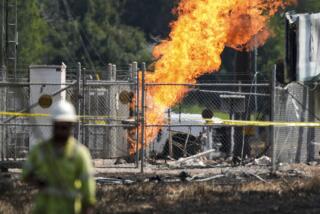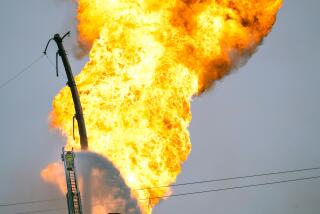Crews close to excavating ruptured section of oil pipeline
Reporting from Santa Barbara â Investigators are nearing an important step in determining what caused an underground oil pipeline last week to rupture and release as much as 101,000 gallons of crude along the Santa Barbara County coast.
Workers on Tuesday dug down to the soil immediately surrounding the spot where the pipeline broke. The pipelineâs owner, Plains All American Pipeline, said the ruptured section of pipe will be excavated and removed for inspection Wednesday.
The step is crucial in identifying the cause of the break, which sent as much as 21,000 gallons of oil downhill from the spill site into a storm culvert and into the Pacific.
A third-party metallurgist is monitoring the dig to make sure the ruptured section of pipe is preserved for the later testing to determine the condition of the pipe when it failed, said Rick McMichael, director of pipeline operations for Plains. Corrosion, pressure and other possible contributing factors will be investigated.
The company said Monday that it will also investigate the integrity of four other locations along Line 901, which transports crude oil 11 miles from Las Floras to Gaviota then to refineries throughout Southern California.
Plains official Patrick Hodgins said the company will dig down to the four locations to confirm the results of an internal diagnostic tool called a smart pig, which snaked through the pipeline two weeks before the spill to check the pipeâs condition.
Plains officials have not disclosed what the inspection found at those four locations except to say they may need to look at the pipeâs thickness or check it for dents.
Community volunteers began assisting Tuesday in the cleanup effort, which officials say has swelled to involve just over 950 workers. That includes members of the Coast Guard, the California Department of Fish and Wildlife, the U.S. Environmental Protection Agency and hundreds of contractors.
Since the spill, 25 oiled birds have been rescued, along with 18 marine mammals. Thirteen birds and eight mammals have died, officials said.
About 20 volunteers with plastic pails crawled on their hands and knees at Goleta beach and separated sand from tar balls while state officials looked on.
Scientists took samples of the oil to determine if it was from the spill or from natural seepage off the coast.
Clad in a white protective suit with a head of messy hair tucked under a Dodgers cap, UC Santa Barbara chemistry student Henry Morse was among those who signed up for training the day before.
âIt is important to get out here and start helping out,â Morse said.
Twitter: @jpanzar
More to Read
Sign up for Essential California
The most important California stories and recommendations in your inbox every morning.
You may occasionally receive promotional content from the Los Angeles Times.










